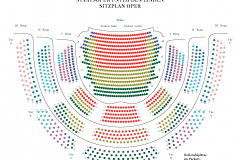Madama Butterfly
Mo | Tu | We | Th | Fr | Sa | Su |
Madama Butterfly
Tragedia giapponese in three acts (1904)
Music by Giacomo Puccini
Text by Giuseppe Giacosa and Luigi Illica after David Belasco
Duration: approx. 2 hours 50 minutes, including one interval after Act One
Language: Italian, with German and English surtitles
Recommended age: 12 years and older
Lieutenant Pinkerton has fallen in love with the geisha Cio-Cio-San, known as Madama Butterfly, and wants to marry her according to Japanese custom without entering into a permanent relationship. But Butterfly truly loves Pinkerton and has a child by him. For years she waits in vain for the lieutenant to return. When Pinkerton does return, he arrives with his new American wife to pick up the child, and Butterfly stabs herself with a dagger.
Madama Butterfly is based on a novella that is allegedly a true story. When American fleets forced the opening of Japanese ports in around the mid-19th century, Japanese culture started to influence the West, not just vice versa. Soon operas and operettas were set in this new-found country, which, despite its rapid technological progress, promised a very different modernity through the preservation of its own culture. Giacomo Puccini incorporated the exoticism of Japan’s setting and its music far more than through mere colonialist appropriation. He studied sources of Japanese music, integrated original songs into his score and was inspired to write sophisticated instrumentation and distinctive timbres. These combine to make his "Japanese tragedy" one of the most touching operas in history. Eike Gramss’ production deals sensitively with this clash between two cultures in a scintillating Japanese setting.
Synopsis
Act 1
In 1904, a U.S. naval officer named Pinkerton rents a house on a hill in Nagasaki, Japan, for himself and his soon-to-be wife, "Butterfly". Her real name is Cio-Cio-San (from the Japanese word for "butterfly" (蝶々, chōchō, pronounced [tɕoꜜːtɕoː]); -san is a plain honorific). She is a 15-year-old Japanese girl whom he is marrying for convenience, and he intends to leave her once he finds a proper American wife, since Japanese divorce laws are very lax. The wedding is to take place at the house. Butterfly had been so excited to marry an American that she had earlier secretly converted to Christianity. After the wedding ceremony, her uninvited uncle, a bonze, who has found out about her conversion, comes to the house, curses her and orders all the guests to leave, which they do while renouncing her. Pinkerton and Butterfly sing a love duet and prepare to spend their first night together.
Act 2
Three years later, Butterfly is still waiting for Pinkerton to return, as he had left shortly after their wedding. Her maid Suzuki keeps trying to convince her that he is not coming back, but Butterfly does not believe her. Goro, the marriage broker who arranged her marriage, keeps trying to marry her off again, but she does not listen to him either. The American consul, Sharpless, comes to the house with a letter which he has received from Pinkerton which asks him to break some news to Butterfly: that Pinkerton is coming back to Japan, but Sharpless cannot bring himself to finish it because Butterfly becomes very excited to hear that Pinkerton is coming back. Sharpless asks Butterfly what she would do if Pinkerton were not to return. She then reveals that she gave birth to Pinkerton's son after he had left and asks Sharpless to tell him.
From the hill house, Butterfly sees Pinkerton's ship arriving in the harbour. She and Suzuki prepare for his arrival, and then they wait. Suzuki and the child fall asleep, but Butterfly stays up all night waiting for him to arrive.
Act 3
Suzuki wakes up in the morning and Butterfly finally falls asleep. Sharpless and Pinkerton arrive at the house, along with Pinkerton's new American wife, Kate. They have come because Kate has agreed to raise the child. But, as Pinkerton sees how Butterfly has decorated the house for his return, he realizes he has made a huge mistake. He admits that he is a coward and cannot face her, leaving Suzuki, Sharpless, and Kate to break the news to Butterfly. Agreeing to give up her child if Pinkerton comes himself to see her, she then prays to statues of her ancestral gods, says goodbye to her son, and blindfolds him. She places a small American flag in his hands and goes behind a screen, stabbing herself with her father's seppuku knife. Pinkerton rushes in, but he is too late, and Butterfly dies.
Program and cast
Cast – 30 November 2025, 3 December 2025, 6 December 2025, 10 December 2025
Musical Director: Tomáš Netopil
Director: Eike Gramss
Set Design, Costumes: Peter Sykora
Chorus Master: Dani Juris
Cio-Cio-San: Corinne Winters
Suzuki: Natalia Skrycka
Kate Pinkerton: Sandra Laagus
Benjamin Franklin Pinkerton: Brian Jagde
Sharpless: Lauri Vasar
Goro: Andrés Moreno García
PRINCE YAMADORI: Irakli Pkhaladze
UNCLE BONZE: N.N.
COMMISSIONER: Hanseong Yun
Staatsopernchor, Staatskapelle Berlin
Cast – 22 April 2026, 24 April 2026, 26 April 2026, 30 April 2026
Musical Director: Keri-Lynn Wilson
Director: Eike Gramss
Set Design, Costumes: Peter Sykora
Chorus Master: Dani Juris
Cio-Cio-San: Elena Guseva
Suzuki: Natalia Skrycka
Kate Pinkerton: Sandra Laagus
Benjamin Franklin Pinkerton: Najmiddin Mavlyanov
Sharpless: Arttu Kataja
Goro: Junho Hwang
PRINCE YAMADORI: Irakli Pkhaladze
UNCLE BONZE: Manuel Winckhler
COMMISSIONER: Hanseong Yun
Staatsopernchor, Staatskapelle Berlin
State Opera Unter den Linden
Staatsoper Unter den Linden is one of Berlin's most prestigious opera houses, with a rich history and significant cultural impact.
History:
The Staatsoper Unter den Linden was originally built between 1741 and 1743, under the direction of architect Georg Wenzeslaus von Knobelsdorff. It was commissioned by Frederick II of Prussia and was initially named the Königliche Oper (Royal Opera). The opera house has undergone several renovations and reconstructions, notably after World War II damage. It reopened in 1984, following a major renovation.
Construction:
The original design was characterized by its Baroque style, featuring an elegant façade and a grand entrance. The building was reconstructed in the 1950s and 1980s, maintaining its classical exterior while modernizing the interior. The façade features a classic portico with six Corinthian columns and a prominent central pediment.
Interior:
The interior is known for its opulent and classical design. The auditorium is renowned for its acoustics and grandeur, with luxurious velvet seats and elaborate decorations. The stage and seating areas have been updated to meet modern performance standards while preserving historical aesthetics.
Concerts and Performances:
The Staatsoper Unter den Linden hosts a variety of performances, including operas, orchestral concerts, and ballet. It is home to the Staatskapelle Berlin, one of Germany's leading orchestras. The opera house is celebrated for its high-quality productions and its role in Berlin’s vibrant cultural scene.
JOURNEY
The Staatsoper Unter den Linden has completely barrier-free access due to its excellent public transport connections.
ADDRESS: Unter den Linden 7; 10117 Berlin
SUBURBAN RAILWAY
S+U Friedrichstraße (S1, S2, S5, S7, S25, S75)
SUBWAY
Hausvogteiplatz (U2)
Museumsinsel (U5)
Stadtmitte (U2, U6)
Unter den Linden (U5, U6)
BUS
Staatsoper (100, 245, 300)
Unter den Linden/Friedrichstraße (100, 147, 245, 300, N6)
PARKING
Q-PARK parking garage Unter den Linden/Staatsoper
Bebelplatz, 10117 Berlin
There are five electric charging stations in the parking garage. Further information can be found here.
The underground car park on Bebelplatz offers disabled parking spaces and direct access to the opera house. On entering the car park between 5.30pm and 11.30pm, the maximum parking fee is €7. To use this tariff, enter your parking ticket in one of the pay machines and the message »Theatertarif« will appear on the display. Please note that it is not possible to use the tariff if you enter the car park before 5.30pm. so it will not be shown on the display. TIP: If you pay the theatre tariff at the pay machine before the event, you can avoid unnecessary waiting after the show.

 EN
EN DE
DE IT
IT FR
FR ES
ES RU
RU JP
JP RO
RO
 Seating plan
Seating plan 